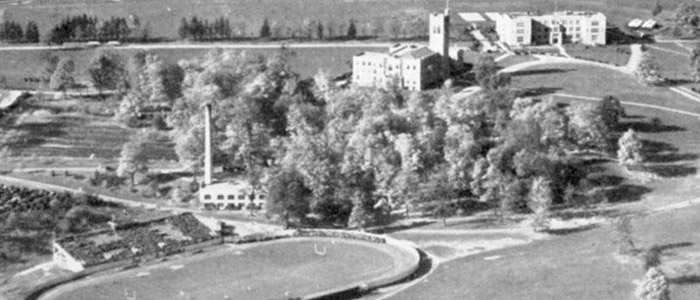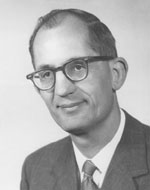History & Facts
The University of Western Ontario celebrated its official centenary in 1978. However, actual instruction did not begin until 1881, when classes were given under the supervision of eight Church of England clergymen. In 1882 James Bowman (1853-1936) was appointed as Professor of Practical Chemistry to lecture a class of fifteen medical students. Bowman taught until 1912. In 1915 he published a study on the preparation of crystallized metals in the Journal of the American Chemical Society. This paper represents the first Departmental publication. Bowman died in 1936. His portrait in oil, which had been painted in 1932, was given to the University by his son, Dr. J. T. Bowman, and today it hangs in the lounge of the Chemistry Department he founded over a century ago.
First Chemistry publication from Western:
A Method of Reducing Some Metals in Crystallized Form on Glass Slips as Permanent Microscope Mounts. Jas. H. Bowman, J. Am. Chem. Soc. 1915, 37, 1468–1471.
In 1923, John A. Gunton, a McMaster graduate who had taken his Ph.D. at Illinois, was appointed Head of Department, a position he was to retain for the next 36 years. In 1924 all the Science departments moved to the Natural Sciences Building [now Physics and Astronomy] on the present campus, in the same year the first B.Sc. in Chemistry was granted.

The campus as it was in 1933. From left to right the three buildings are the heating plant, University College, and the Science Building (now Physics and Astronomy), all completed in 1924.
By 1948 the Department had five faculty members. This expansion continued through the 1950's when three more appointments were made. With this expansion in numbers came the change from a department dedicated to undergraduate teaching to one in which graduate education and research received increasing emphasis. The first Ph.D. in Chemistry was awarded in 1953.
In 1959 Fred Pattison was appointed head of the Department. In the same year the University committed $ 100,000, a large sum in those days, towards modernizing the Department. Two outstanding chemists were appointed, Paul de Mayo (organic) and Don Bradley (inorganic), both from England. Under the leadership of Fred Pattison and these two senior appointees, research activity increased rapidly in the next six years. The Chemistry faculty grew to 21 in 1965. In the same year, Chemistry moved into a new building. Fred Pattison resigned from the Department in order to enter Medical school (at the age of 42) and he later served as Director of UWO's Student Health Services. The development of the Department after 1965 built on the strong foundation he established during his six years as Head, including his successful efforts to obtain a new building for the Department.
 Fred Pattison, head of the Chemistry Department from 1959-1965. See the Fred Pattison Senior Lectureship.
Fred Pattison, head of the Chemistry Department from 1959-1965. See the Fred Pattison Senior Lectureship.
The expansion of the Department continued through the 1960's and 1970's under Head Howard Clark. In 1971, the Photochemistry Unit was established. It quickly gained a world-wide reputation for expertise in organic photochemistry, flash photolysis, picosecond time-resolved spectroscopy, and fluorescence spectroscopy. Another important step was taken in 1981, with the founding of Surface Science Western. This analytical facility, at that time unique in Canada, offers a wide range of techniques for studying surfaces. Currently, a staff of six, under the direction of Stewart McIntyre, operate the laboratory. In 1986, Western's expertise in this area was increased by the award of two NSERC industrial fellowships to Peter Norton (Chemistry) and Ian Mitchell (Physics). Together with two adjunct appointments, these faculty established a new inter-departmental group named Interface Science Western. In 1979 a grant from NSERC and UWO was used for the construction of a Canadian beam line at the Aladdin synchrotron in Wisconsin. Since the completion of this facility, it has been used by several generations of graduate students and research workers under the direction of Mike Bancroft, T. K. Sham, Peter Norton, and others.
Today the Department of Chemistry has about 40 active faculty members that represent a wide variety of research interests, including analytical, biological, environmental, inorganic, materials, organic, physical, and theoretical chemistry. The work of these faculty is supported by 25 research, laboratory, and secretarial staff. Based on material collected and compiled by Christopher Willis
Historical photographs courtesy of The J.J. Talman Regional Collection, The D.B. Weldon Library, and The University of Western Ontario.
Facts and Figures
Program Dates
- Department founded in 1882
- First Honours BSc in 1924
- First MSc in 1927
- First PhD in 1953
Our Students
- 2000th BSc by 1990
- 200th PhD by 1986
- 300th PhD by 1998
Annual Numbers
- Over 3000 Students Taught Annually
- About 100 Students Graduating Annually
- Currently 40 with the Honours BSc
Our Faculty
- 3 Faculty Members in 1925
- 6 Faculty Members in 1950
- 8 Faculty Members in 1959
- 30 Faculty Members in 1975
- 31 Faculty Members in 2000
Our Staff
- 11 Staff Members by 1960
- 25 Staff Members in 2000
Publications
- First publication in 1915
- 100 publications by 1962
- 1000 publications by 1975
- 2000 publications by 1985
- 4000 publications by 2000
Research Revenue
- Average Annual Research Revenue $4,000,000
Our Building
- Independent Chemistry Building in 1965
- Chemistry Addition in 1975
- Fumehood Renovations in 1997
- B&G Synthetic Expansion (Jones, Pagenkopf, Ragogna), 2006
- Materials Science Addition, 2008
Current Enrollments
- Year-1 students: ~4,500 (service)
- Year-2 students: ~90 (core); ~2,100 (service)
- Year-3 students: ~75 (core); ~350 (extradepartmental)
- Year-4 students: ~45 (honours)
- Intersession/Summer School: ~600

